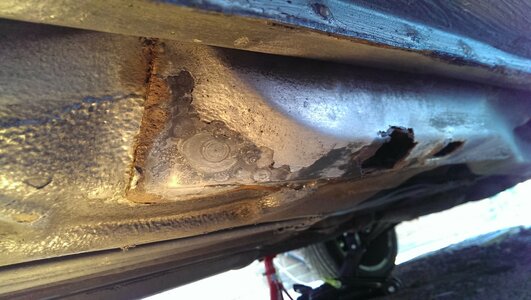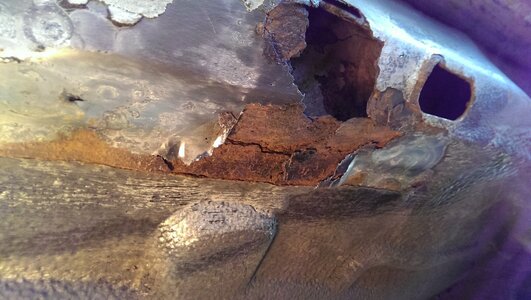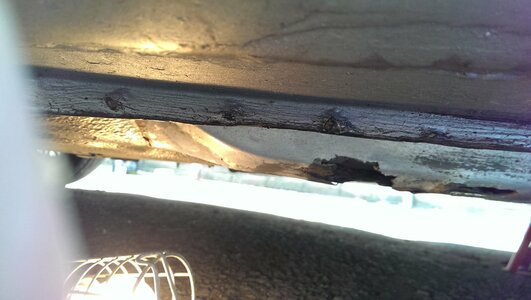What Have You Done to Your Cougar Today?
- Thread starter Axximilli
- Start date
You are using an out of date browser. It may not display this or other websites correctly.
You should upgrade or use an alternative browser.
You should upgrade or use an alternative browser.
You know, I do think that the C1 bumper cover suits the car's lines better, and of course you have a body kit that makes that doubly true.
But to be honest, I really can't find it in myself to actually hate the C2 front end. I mean, most of it is the same as the C1, and the slats do modernise it to the later Ford design language, right?
But to be honest, I really can't find it in myself to actually hate the C2 front end. I mean, most of it is the same as the C1, and the slats do modernise it to the later Ford design language, right?
Is it me, or does DG look a little downhearted and wistful in this photo? You can almost imagine her sighing in resignment, "I used to be a real looker..."
..........most of it is the same as the C1, and the slats do modernise it to the later Ford design language, right?
In stock form I definitely prefer the facelift bumper, especially with blacked out slats as per Ginga's car, the US facelift rear bumper is far nicer too.
shame there were no decent facelift bodykits.....Wings West did one it's horrible!
I don't know what everyone's complaining about on the bumper. No one made an aftermarket lip for the facelift bumper because it doesn't NEED it. Pre facelift seriously looks ugly unless you have a body kit on it. Roush new it. Thats why we have the front lip that everyone loves so much. Wings West knew it and gave us a decent alternative for those who couldnt afford Roush. And y'all over there have some seriously nice looking front add ons for the pre face lift bumper. The ONLY thing the facelift bumper needs is a lip to lower it.
As for it looking like a sad kitty,,, watch the original cartoon of alice in wonderland when that freaky cat disappears and you can still see his eyes and smile and then look at the front of the car again. If you add in the fog lights to the ends of the slats on the bumper I swear it looks like that cat from the angle of that pic. Ain't nothin but a cat with an evil grin going on there.
As for it looking like a sad kitty,,, watch the original cartoon of alice in wonderland when that freaky cat disappears and you can still see his eyes and smile and then look at the front of the car again. If you add in the fog lights to the ends of the slats on the bumper I swear it looks like that cat from the angle of that pic. Ain't nothin but a cat with an evil grin going on there.
Is it me, or does DG look a little downhearted and wistful in this photo? You can almost imagine her sighing in resignment, "I used to be a real looker..."
Definetly. Don't worry girl, Uncle Al will have you sorted in no time.
IMHO any facelift that takes away perfectly good boobs cannot be said to be an improvement
Wings West knew it and gave us a decent alternative for those who couldnt afford Roush.
Why Sir, that's fighting talk! Had I a gauntlet about my person (and were I in Georgia), I should throw it at your feet and challenge you to a duel at dawn to defend the honour of the Wings West bodykit!
Sure you would,,, were you in Georgia,, we'd toss some bacon in the skillet and work on stripping a car so that way when you got back to the UK and I finally got this thing running , you'd have bragging rights at all the cougars fest to come about how you got to help create El Couguar. Besides you cant argue with the fact that the WW kit did in fact cost less then the Roush therefore making it cheaper lolWhy Sir, that's fighting talk! Had I a gauntlet about my person (and were I in Georgia), I should throw it at your feet and challenge you to a duel at dawn to defend the honour of the Wings West bodykit! [emoji38]
Sure you would,,, were you in Georgia,, we'd toss some bacon in the skillet and work on stripping a car so that way when you got back to the UK and I finally got this thing running , you'd have bragging rights at all the cougars fest to come about how you got to help create El Couguar.
I'd love that mate, and we could have a mutual military geek-off at the same time. Naturally, the bacon would need to be thick-sliced, lean, smoked, back rashers (most definitely not microwaved :stop
Besides you cant argue with the fact that the WW kit did in fact cost less then the Roush therefore making it cheaper lol
I bought mine secondhand, where the prices equal out, and we all know that the Wings West is by far the best looking kit for a Cougar.
We can have whatever bacon we can find in the store. We're probably gonna get stuck with that canadian stuff though cause here theres only one other thing sold as bacon. Looking at it compared to the stuff you guys have shown its no where close.I'd love that mate, and we could have a mutual military geek-off at the same time. Naturally, the bacon would need to be thick-sliced, lean, smoked, back rashers (most definitely not microwaved :stopand I would have to bring some Yorkshire tea across. [emoji106]
I bought mine secondhand, where the prices equal out, and we all know that the Wings West is by far the best looking kit for a Cougar.
The part where the WW kit wins the race is that they still make it so you can buy a new one. And if you catch a curb with yours its not months or years searching for another one. To be honest though.. they both suck compared to the wide body kit on Luci [emoji16]
In stock form I definitely prefer the facelift bumper, especially with blacked out slats as per Ginga's car, the US facelift rear bumper is far nicer too.
Each to their own
Flap Motor Blues...
Ever since I've had my cat, 1st August last year, it's had a bit of a problem with the 'Flap Motor'. In the first 50 miles I had to keep winding down the windows and eventually stop and switch off to prevent myself getting roasted - it would then somehow 'reset' itself. Funnily enough it slowly got better, at least until last week, probably likes regular use like an A/C. So having already got a spare unit I decided to 'overhaul' the spare which had the benefit of familiarisation and testing the motor. I found it a bit fiddly to get apart, probably because I was afraid of breaking off the tabs that hold it together. Then I discovered that short pieces of discarded cable tie end could be put under all the tabs and the case prised apart with a thin screwdriver.
There seemed way too much grease inside, so I cleaned everything up. The wiper on the servo pot seemed a likely problem area as it was cacked up with yet more grease, but the tracks looked good. Spot of clock oil on both ends of the motor which is of quite a high quality and appears to have replaceable brushes. About 6 Volts on the motor seems enough to get it spinning to work the oil in, and can be reversed to make sure it spins as well the other way, before clearing away the surplus. Reassembled after putting silicon grease on all the plastic gears, shafts etc., and I lubed the wiper / carbon tracks with contact oil.
Apart from the awkward location / top screws, I found it hard to re-engage the shaft. Switching on and setting to hot, or cold, or Goldilocks temperatures didn't work either. I eventually figured out it needed to be a tad above LO to engage, so switched the ignition off whilst it was rising and that worked. Test run seemed to show it is working perfectly ( fingers crossed ). Also reconned the one that came out that was also cacked up with grease, same treatment to wiper / track. Quickly pulled out the plug and used it to verify the repaired unit was also working, whilst it dangled near clutch pedal...
Ever since I've had my cat, 1st August last year, it's had a bit of a problem with the 'Flap Motor'. In the first 50 miles I had to keep winding down the windows and eventually stop and switch off to prevent myself getting roasted - it would then somehow 'reset' itself. Funnily enough it slowly got better, at least until last week, probably likes regular use like an A/C. So having already got a spare unit I decided to 'overhaul' the spare which had the benefit of familiarisation and testing the motor. I found it a bit fiddly to get apart, probably because I was afraid of breaking off the tabs that hold it together. Then I discovered that short pieces of discarded cable tie end could be put under all the tabs and the case prised apart with a thin screwdriver.
There seemed way too much grease inside, so I cleaned everything up. The wiper on the servo pot seemed a likely problem area as it was cacked up with yet more grease, but the tracks looked good. Spot of clock oil on both ends of the motor which is of quite a high quality and appears to have replaceable brushes. About 6 Volts on the motor seems enough to get it spinning to work the oil in, and can be reversed to make sure it spins as well the other way, before clearing away the surplus. Reassembled after putting silicon grease on all the plastic gears, shafts etc., and I lubed the wiper / carbon tracks with contact oil.
Apart from the awkward location / top screws, I found it hard to re-engage the shaft. Switching on and setting to hot, or cold, or Goldilocks temperatures didn't work either. I eventually figured out it needed to be a tad above LO to engage, so switched the ignition off whilst it was rising and that worked. Test run seemed to show it is working perfectly ( fingers crossed ). Also reconned the one that came out that was also cacked up with grease, same treatment to wiper / track. Quickly pulled out the plug and used it to verify the repaired unit was also working, whilst it dangled near clutch pedal...
Sounds like a good shift there. IS the one you've taken out serviceable then or is it borked? Only curious after your breakdown and assessment, not sure what could go wrong with them?
Sounds like a good shift there. IS the one you've taken out serviceable then or is it borked? Only curious after your breakdown and assessment, not sure what could go wrong with them?
Thanks for the question Sam, and yes I think they are both now serviceable. From my experience of similar things electronic; servos, mixing desks etc., I've seen a number of 'modes of failure' that seem to put these flap motors at risk. Too much torque for the plastic gears being one, but doesn't seem to be happening here ( but it takes a lot of force to move that flap it strikes me ). Worn brushes and commutator in the motor again does not seem to be an issue and there looks to be a potential to repair. Lubrication failure again - no, the grease still had the right effect even if drying out.
But the thick film servo potentiometer track and wiper looks like a weak spot. The track itself can wear and create a 'soup' of carbon particles or debris, dust, grease etc., that can prevent a good, even contact with the wiper. In this case there are two tracks and the wiper has many fingers that bridge them at a specific point, so 'double trouble' you could say. Of course, all this manifests itself for the servo, just like a very noisy volume control on an old radio. It could even result in the servo jittering and hunting around constantly which would accelerate the wear.
So what I found was lots of drying up grease, especially under the potentiometer wiper. I removed all the grease including from gears etc., and replaced all but what was on the pot with silicon grease that does not attack plastic ( and you should be using on your battery terminals since it doesn't catch fire either ! ). On the wiper of the pot I put some RadioSpares ( showing my age again, probably RS Components to you ) 'Contact Treatment Oil'. Not sure of the exact formulation of that, but probably silicon oil amonst other things. Anyway, it really is magic stuff for all sorts of contacts and again doesn't catch fire.
Having shoved them back together, I needed to test them. Another potential problem with the flap motor is incorrect temperature feedback from the temperature sensor on the HVAC console. A tiny fan motor behind vertical slits with a thermistor just underneath the facia. So I had blown this out previously with an air duster, before deciding to work on the flap motors. Please note not to 'play' and let the thing scream away like a little siren. To send it to phenomenal RPM like that can break the oil film in the bearing and ruin it. I often put a finger ( but not when moving ) or plastic spout between blades to stop them spinning when doing this.
To test the flap motors, I first tried them by plugging in the cable and dangling them down so I could see the output shaft. A bit of bent wire, serving like a watch hand would enhance visibility here. I then put the ignition on and made sure the fan was on 'auto' and 'mode' to vents and floor, but not all the way to the right - demist, as that seems to behave differently. Then I slowly changed the temperature settings down to LO and then up to high and watched the shaft move. Since it got no corresponding 'feedback' from temperature sensor, it did not behave quite normally, but showed it was moving smoothly thru a considerable angle to try to decrease / increase heat by moving the shaft that would normally move the flap.
Sorry for the long winded explanation. My job used to be to try and fix oilfield systems around the world, by looking at spare equipment in the workshop from a base in the UK. They were often places you did NOT want to go to. So I found that clarity and completeness saved by butt many times. Cheers - Noel
Got under Claus this morning, armed with lamp, wire brush, kurust, and waxoyl.
All went well till I lifted some old underseal and found it wet through, then a hole that got bigger...
Gutted
The usual thing I’m afraid mate!
Sent from my iPhone using Tapatalk
How bad is this, gonna need more than filler huh? 
Both sides are all wire brushed down now and treated with kurust.
Just waiting for it to dry then blathering it in waxoyl.
I also found most of the sill drain holes blocked up but have cleared them.
Both sides are all wire brushed down now and treated with kurust.
Just waiting for it to dry then blathering it in waxoyl.
I also found most of the sill drain holes blocked up but have cleared them.






